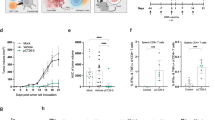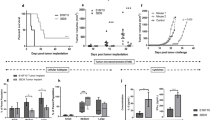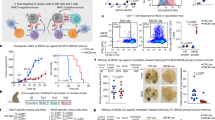Abstract
Cancer vaccine that targets ‘self’-antigens expressed at high levels in tumor cells is a potentially useful immunotherapy, but immunological tolerance often defeats this strategy. Here, we describe the use of a naked DNA vaccine encoding a self tumor antigen, tyrosinase-related protein 2, to whose N-terminus ubiquitin is fused in a ‘nonremovable’ fashion. Unlike conventional DNA vaccines, this vaccine broke the tolerance and induced protective immunity to melanoma in C57BL/6 mice, as evaluated by tumor growth, survival rate and lung metastasis. The protective immunity was cancelled in the proteasome activator PA28α/β knockout mice. Moreover, this vaccination exhibited therapeutic effects on melanoma implanted before vaccination. Our findings provide evidence for the first time that naked DNA vaccines encoding a ubiquitin-fused self-antigen preferentially induce the main effector CD8+ T cells through efficient proteolysis mediated by the ubiquitin–proteasome pathway, and lead the way to strategies aimed at targeting tissue differentiation antigens expressed by tumors.
This is a preview of subscription content, access via your institution
Access options
Subscribe to this journal
Receive 12 print issues and online access
$259.00 per year
only $21.58 per issue
Buy this article
- Purchase on Springer Link
- Instant access to full article PDF
Prices may be subject to local taxes which are calculated during checkout






Similar content being viewed by others
References
Rosenberg SA . Cancer vaccines based on the identification of genes encoding cancer regression antigens. Immunol Today 1997; 18: 175–182.
Wang RF et al. Identification of TRP-2 as a human tumor antigen recognized by cytotoxic T lymphocytes. J Exp Med 1996; 184: 2207–2216.
Weber LW et al. Tumor immunity and autoimmunity induced by immunization with homologous DNA. J Clin Invest 1998; 102: 1258–1264.
Overwijk WW et al. gp100/pmel 17 is a murine tumor rejection antigen: induction of ‘self’-reactive, tumoricidal T cells using high-affinity, altered peptide ligand. J Exp Med 1998; 188: 277–286.
Bowne WB et al. Coupling and uncoupling of tumor immunity and autoimmunity. J Exp Med 1999; 190: 1717–1722.
Tüting T et al. Induction of tumor antigen-specific immunity using plasmid DNA immunization in mice. Cancer Gene Ther 1999; 6: 73–80.
Steitz J et al. Genetic immunization with a melanocytic self-antigen linked to foreign helper sequences breaks tolerance and induces autoimmunity and tumor immunity. Gene Therapy 2002; 9: 208–213.
Engelhard VH et al. Antigen derived from melanocyte differentiation proteins: self-tolerance, autoimmunity, and use for cancer immunotherapy. Immunol Rev 2002; 188: 136–146.
Inaba K, Young JW, Steinman RM . Direct activation of CD8+ cytotoxic T lymphocytes by dendritic cells. J Exp Med 1987; 166: 182–194.
Sato M et al. Th1 cytokine-conditioned bone marrow-derived dendritic cells can bypass the requirement for Th functions during the generation of CD8+ CTL. J Immunol 2001; 167: 3687–3691.
Nishitani MA et al. A convenient cancer vaccine therapy with in vivo transfer of interleukin 12 expression plasmid using gene gun technology after priming with irradiated carcinoma cells. Cancer Gene Ther 2002; 9: 156–163.
Tanaka K, Kasahara M . The MHC class I ligand-generating system: roles of immunoproteasomes and the interferon-gamma-inducible proteasome activator PA28. Immunol Rev 1998; 163: 161–176.
Rock KL, York IA, Saric T, Goldberg AL . Protein degradation and the generation of MHC class I-presented peptides. In: Dixon FJ (ed). Advances in Immunology, Vol 80. Academic Press: Oxford, 2002, pp 1–71.
Kloetzel P-M . Antigen processing by the proteasome. Nat Rev Mol Cell Biol 2001; 2: 179–187.
Xiang R et al. An autologous oral DNA vaccine protects against murine melanoma. Proc Natl Acad Sci USA 2000; 97: 5492–5497.
Johnson ES, Ma PC, Ota IM, Varshavsky A . A proteolytic pathway that recognizes ubiquitin as a degradation signal. J Biol Chem 1995; 270: 17442–17456.
Zhang M et al. Ubiquitin-fusion degradation pathway plays an indispensable role in naked DNA vaccination with a chimeric gene encoding a syngeneic cytotoxic T lymphocyte epitope of melanocyte and green fluorescent protein. Immunology 2004; 112: 567–574.
Murata S et al. Immunoproteasome assembly and antigen presentation in mice lacking both PA28α and PA28β. EMBO J 2001; 20: 5898–5907.
van den Eynde BJ, van der Bruggen P . T cell defined tumor antigens. Curr Opin Immunol 1997; 9: 684–693.
Rosenberg SA . A new era for cancer immunotherapy based on the genes that encode cancer antigens. Immunity 1999; 10: 281–287.
Bloom MB et al. Identification of tyrosinase-related protein 2 as a tumor rejection antigen for the B16 melanoma. J Exp Med 1997; 185: 453–459.
Lindauer M et al. The molecular basis of cancer immunotherapy by cytotoxic T lymphocytes. J Mol Med 1998; 76: 32–47.
Noppen C et al. Naturally processed and concealed HLA-A2.1-restricted epitopes from tumor-associated antigen tyrosinase-related protein-2. Int J Cancer 2000; 87: 241–246.
Rock KL et al. Inhibitors of the proteasome block the degradation of most cell proteins and the generation of peptides presented on MHC class I molecules. Cell 1994; 78: 761–771.
Cerundolo V et al. The proteasome-specific inhibitor lactocystin blocks presentation of cytotoxic T lymphocyte epitopes in human and murine cells. Eur J Immunol 1997; 27: 336–341.
Craiu A et al. Lactacystin and clasto-lactacystin b-lactone modify multiple proteasome β-subunits and inhibit intracellular protein degradation and major histocompatibility complex class I antigen presentation. J Biol Chem 1997; 272: 13437–13445.
Hershko A, Ciechanover A . The ubiquitin system. Annu Rev Biochem 1998; 67: 425–479.
Rodriguez F, Zhang J, Whitton JL . DNA immunization: ubiquitination of a viral protein enhances cytotoxic T-lymphocyte induction and antiviral protection but abrogates antibody induction. J Virol 1997; 71: 8497–8503.
Leitner WW et al. Alphavirus-based DNA vaccine breaks immunological tolerance by activating innate antiviral pathway. Nat Med 2003; 9: 33–39.
Overwijk WW et al. Vaccination with a recombinant vaccinia virus encoding a ‘self’ antigen induces autoimmune vitiligo and tumor cell destruction in mice: requirement for CD4+ T lymphocytes. Proc Natl Acad Sci USA 1999; 96: 2982–2987.
Mackensen A et al. Phase I study in melanoma patients of a vaccine with peptide-pulsed dendritic cells generated in vitro from CD34+ hematopoietic progenitor cells. Int J Cancer 2000; 86: 385–392.
Bronte V et al. Genetic vaccination with ‘self’ tyrosinase-related protein 2 causes melanoma eradication but not vitiligo. Cancer Res 2000; 60: 253–258.
Sakai T et al. Gene gun-mediated delivery of an interleukin-12 expression plasmid protects against infections with the intracellular protozoan parasites Leishmaniamajor and Trypanosoma cruzi in mice. Immunology 2000; 99: 615–624.
Sakai T et al. Gene gun-based co-immunization of merozoit surface protein-1 cDNA with IL-12 expression plasmid confers protection against lethal Plasmodium yoelii in A/J mice. Vaccine 2003; 21: 1432–1444.
Nanni P et al. Interleukin 12 gene therapy of MHC-negative murine melanoma metastases. Cancer Res 1998; 58: 1225–1230.
Matzinger P . The JAM test. A simple assay for DNA fragmentation and cell death. J Immunol Methods 1991; 145: 185–192.
Acknowledgements
This work was supported by grants-in-aid from the Ministry of Education, Culture, Sport, Science, and Technology of Japan (15019075, 15025255, 15390136, 15659265).
Author information
Authors and Affiliations
Rights and permissions
About this article
Cite this article
Zhang, M., Obata, C., Hisaeda, H. et al. A novel DNA vaccine based on ubiquitin–proteasome pathway targeting ‘self’-antigens expressed in melanoma/melanocyte. Gene Ther 12, 1049–1057 (2005). https://doi.org/10.1038/sj.gt.3302490
Received:
Accepted:
Published:
Issue Date:
DOI: https://doi.org/10.1038/sj.gt.3302490
Keywords
This article is cited by
-
Induced pluripotent stem cell-derived dendritic cell vaccine therapy genetically modified on the ubiquitin-proteasome system
Gene Therapy (2023)
-
DNA Vaccine Targeting Gonadotropin-Releasing Hormone Receptor and Its Application in Animal Contraception
Molecular Biotechnology (2019)
-
Expression, Polyubiquitination, and Therapeutic Potential of Recombinant E6E7 from HPV16 Antigens Fused to Ubiquitin
Molecular Biotechnology (2017)
-
DNAVaxDB: the first web-based DNA vaccine database and its data analysis
BMC Bioinformatics (2014)
-
Therapy of established B16-F10 melanoma tumors by a single vaccination of CTL/T helper peptides in VacciMax®
Journal of Translational Medicine (2007)



